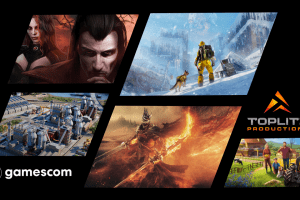GDC Europe 2016 State of the Industry:
VR interest is rising, but PC and mobile still reign.
In an effort to better understand the state of the European game industry ahead of GDC Europe, Game Developers Conference officials have surveyed over 800 European based games industry professionals who have attended a past GDC event.
The data gathered from that survey has been compiled into the fourth annual GDC Europe State of the Industry report, and it offers both an interesting snapshot of the European game industry as it stands now and some perspective on how it has changed over the past year.
Rising interest in VR game development, especially for the HTC Vive, deepening concern about crowdsourced funding and a growing focus on releasing games for PlayStation 4 and Xbox One are among the notable trends outlined by the findings from this year’s survey.
We’ve taken the liberty of summarizing some of those notable highlights below. For more details, you can register to download the full report at the GDC Europe State of the Industry hub.
PC and mobile remain the most popular platforms – but consoles are gaining
So where are European game makers releasing their work?
When asked where their last completed game was released, 49 percent of this year’s survey respondents said PC/Mac, 40.5 percent said Smartphones/Tablets, 17.5 percent said PlayStation 4 and 13.6 percent said Xbox One.
61 percent of this year’s respondents said the game they’re currently working on will see a release on PC/Mac, 46.9 percent said it would see a Smartphone/Tablet release and 29.6 percent said it would come out on PlayStation 4. 25.7 percent said it would see an Xbox One release.
Looking to the future, survey respondents remain focused on PCs and mobile devices — but their interest in contemporary consoles increased. 62.8 percent said they expect to release their next game on PC/Mac, 44.3 percent said they expect to release it on Smartphones/Tablets. 36 percent said it would come out on PlayStation 4, and 30.3 percent said their next game would come out on Xbox One.
When we polled this year’s survey respondents on which platforms interested them most, as developers, the breakdown was a bit different. PC/Mac was most popular with 59.7 percent expressing interest, but it was followed by virtual reality headsets with 48.3 percent interest and the PlayStation 4 with 41.5 percent interest.
Smartphones and tablets may have not ranked as highly in the answers to this question because they were broken out into separate categories, leading 36.9 percent of respondents to say they were currently interested in making games for smartphones and 29.5 percent said they were interested in creating tablet games.
Interest in VR game development is rising
These results show a significant uptick in VR interest year-over-year. In the course of last year’s survey just 33.4 percent of respondents said they were interested in making VR games, placing the platform behind PC/Mac, PlayStation 4, smartphones and tablets in terms of interest. As we just mentioned, this year more European developers are interested in VR than either smartphones or tablets.
But of course, there are multiple different VR platforms. Which ones are European game industry professional making games for? According to this year’s survey, mostly the Oculus Rift and the HTC Vive.
When asked which VR platforms they were currently making games for, 23.1 percent of respondents said the Rift and 22 percent said the Vive. 11.8 percent said the PlayStation VR headset, and it’s important to note that 66.3 percent said they weren’t involved in developing anything for VR/AR headsets.
That’s a big surge in development for the Vive, since last year when we asked the same question just 3.9 percent said they were working on a game for SteamVR. The first and so far only SteamVR headset, of course, has proven to be the HTC Vive.
It’s also important to note that the State of the Industry survey is constantly evolving and improving. Thus, last year’s survey only queried developers on SteamVR, PlayStation VR (then called Project Morpheus), the Oculus Rift and the Gear VR headsets.
For a bit more context on where Europe was at in terms of VR game development last year, 73.4 percent of respondents said they weren’t making any VR/AR games, 22.1 percent said they were working on games for the Oculus Rift, and 7.3 percent said they were making games for Samsung’s Gear VR headset.
Going forward, European game industry opinions on VR development seem to be on an upswing. While the majority of survey respondents (again, 66.3 percent) said they weren’t currently involved in VR development, when asked which VR platforms most interest them right now, just 34.5 percent said “not applicable/none.” 50 percent said the HTC Vive interested them, 34.1 percent said the Rift was of interest and 33.5 percent selected the PlayStation VR headset.
However, confidence in the VR games market seems to have dipped in the last year. When asked whether they believed VR is a long-term sustainable market, 68.8 percent of this year’s respondents said yes. Last year, that figure was 71.7 percent.
Most European game makers are self-funded
When it comes to funding game development in Europe, most survey respondents seem to be covering expenses using their own funds. When asked to select one or more sources of funding for their work, 57.8 percent of respondents said their funding comes from their company’s existing funds and 32.9 percent said it came from their own personal funds. Beyond that, publishers proved the most popular funding option, with 18.7 percent of respondents saying they had funding from an external publisher.
This was the first year this question was asked as part of the GDC Europe State of the Industry survey, so we can’t compare it to European devs’ past responses on where they found funding.
However, we have kept abreast of how developers feel about crowdsourced funding — and how often they use it. In the past year there’s been a very slight uptick in how many survey respondents use crowdfunding, though the overall interest is still pretty low.
This year 5.2 percent of those surveyed said they were working on a game that had received crowdsourced funding, compared to 4.2 percent last year. 28.8 percent said they were planning to use crowdsourced funding on their future games, down from 34.2 percent last year.
“I think it is an awful way to try to fund a game and would never do it,” wrote one respondent on a survey question which sought opinions on the state of crowdsourced funding in the European game industry.
“More work needs to be done in order to direct consumers to reliable crowdfunding campaigns whilst reestablishing trust in how crowdsourced funds are used by a development team,” wrote another.
And reliably, someone pointed out that crowdsourcing funding is much tricker outside of the United States. “The major crowdsourcing platforms are US-centric, would wish they offered more payment methods and provided more clarity towards EU specific tax and legal aspects.”
GDC Europe 2016 also offers business and networking opportunities to all attendees with a developer-focused Expo Floor area and various networking events.
For more information on GDC Europe, the conference program and exhibitors please visit www.gdceurope.com.







